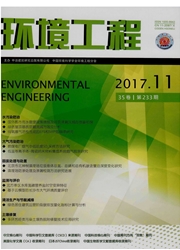

 中文摘要:
中文摘要:
氯消毒广泛应用于海水利用的预处理过程中,以减少生物膜淤积,而消毒过程会导致各类消毒副产物(DBPs)的生成,可能会对海洋生态环境具有潜在危害。系统研究了操作条件和水质对海水氯化消毒过程中生成三卤甲烷(THMs)、卤乙腈(HANs)和卤乙酸(HAAs)的影响。结果表明,氯投加量对DBPs生成的影响最大,随着投氯量的增加,THMs、HANs和HAAs的生成量显著增加,在反应初期随反应时间的延长而增加,随后HANs和HAAs的生成量开始缓慢降低而THMs基本保持不变。随着温度升高,THMs的生成量稳步增加,而HAAs和HANs在分别达到30,25℃后生成量达到最大值,之后随温度的升高而降低。p H对THMs、HANs和HAAs生成的影响相反,在酸性条件下HANs和HAAs的生成量最多,而在碱性条件下THMs的生成量最多。THMs、HANs和HAAs的生成量随溴离子浓度的改变无明显变化,但是随着氨氮浓度的升高,THMs、HANs和HAAs的生成种类和生成量均有明显降低。
 英文摘要:
英文摘要:
Chlorine disinfection is widely used in the pretreatment of seawater. Yet,this treatment leads to the formation of disinfection by-products,which may pose potential adverse effects to the marine ecological environment. A study was conducted on the effects of the operating conditions and seawater quality on the formation of trihalomethanes( THMs),haloacetonitriles( HANs) and haloacetic acids( HAAs). The experimental results indicate that chlorine dosage is the most significant factor to affect the DBPs formation. With the increase of chlorine dosage,the amount of THMs,HANs and HAAs increased significantly. The concentrations of THMs,HANs and HAAs increases during the initial reaction time,and then the concentrations of HANs and HAAs decrease with extended time,while that of THMs remains unchanged. With the increase of temperature,the amount of THMs increases steadily,while that of HANs and HAAs reach a peak at 25 ℃ and 30 ℃ followed by a decrease with elevated temperature. The most of THMs are detected at alkaline conditions,while the most of HAAs and HANs are detected at acid conditions. THMs,HAAs and HANs respond to p H variations almost oppositely. THMs,HANs and HAAs formation is not sensitive to the concentration of bromide,however,ammonia greatly inhibits the formations of these three groups of DBPs.
 同期刊论文项目
同期刊论文项目
 同项目期刊论文
同项目期刊论文
 期刊信息
期刊信息
